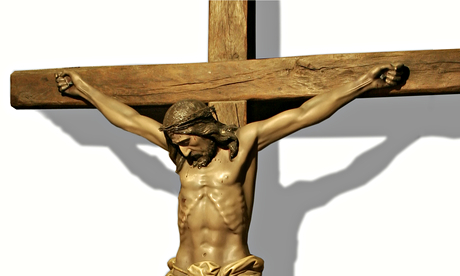
Shakespeare, Richard II About to hand over the crown to Bolingbroke – and so inaugurate the 85‑year cycle of depositions and murders dramatised in the Wars of the Roses plays – the king compares himself in 4.1 to Christ on Good Friday.
Donne, "Good Friday 1613, Riding Westward"
A 401-year-old poem showing Donne at a crossroads in his life, in the year he took religious orders: he is riding away from Christ's crucifixion in the east at Easter, but argues that's fitting as it can't be contemplated directly.
Herbert, "Easter wings"
A devout poem ("Lord ... let me rise / As larks, harmoniously / And sing this day thy victories"), but also a playfully patterned one, with its two wing-shaped verses looking forward to Sterne and Carroll and 20th‑century lay‑out games.
Goethe, Faust
The scholar's fateful meeting with Mephistopheles occurs at Easter, after a chorus of angels glorying in the resurrection stop him killing himself, and he and Wagner walk among people celebrating the festival.
Austen, Pride and Prejudice
Easter marks the novel's turning point, when Elizabeth is staying in Kent, and Darcy (visiting his aunt nearby at Rosings) stuns her by proposing – though she rejects him, the series of events that follows make them allies. The entire romantic fiction genre aptly gets going in the season of renewal.
Tolstoy, Resurrection
In Tolstoy's last novel, – recently cited as inspirational by Folio prize winner George Saunders – the Russian Orthodox Easter service described in Chapter 15 is a touchstone for the repentant and would-be resurrected sinner hero, "one of the brightest memories of his life". And, typically, it's a bit sexy, too.
Yeats, "Easter 1916"
Despite his previous hostility to armed nationalism (and indeed the colour green), Yeats honoured those who died in or after Dublin's Easter Rising as Christ-like martyrs possessing "a terrible beauty".
Hardy, "Unkept Good Fridays"
A ferociously grumpy antidote to religious Easter poems: about recent historical studies of the silent and hidden are anticipated in his tribute to the "unpenned... nameless Christs", "men whom rulers slew / For their goodwill" and other victims of torture and oppression who have no Good Fridays commemorating their suffering.
Faulkner, The Sound and the Fury
Easter 1928 is the setting for three of the four sections of the radically modernist deep south family saga, in which some scenes recall Christ's suffering and others suggest hope of new life.
Yates, Easter Parade
In the Richard Yates novel Joan Didion judged better than Revolutionary Road, Easter is the last moment of innocence for two sisters – one parading, one watching – with lives of frustration ahead of them.

